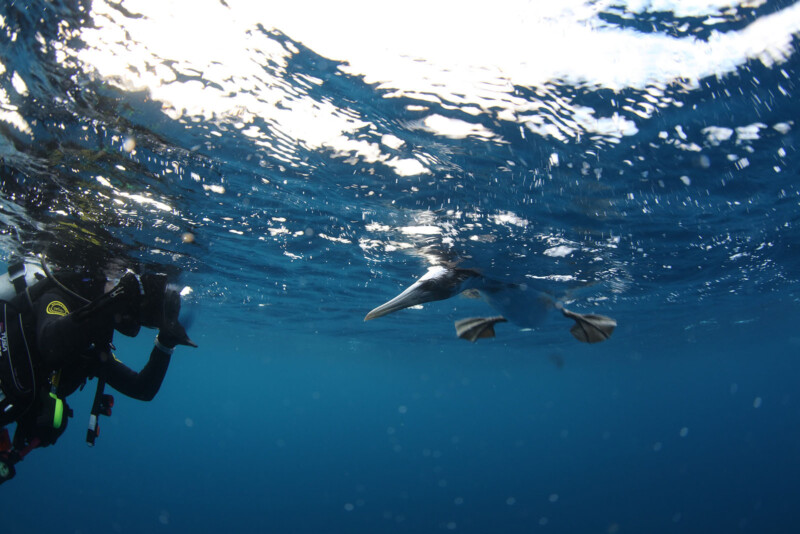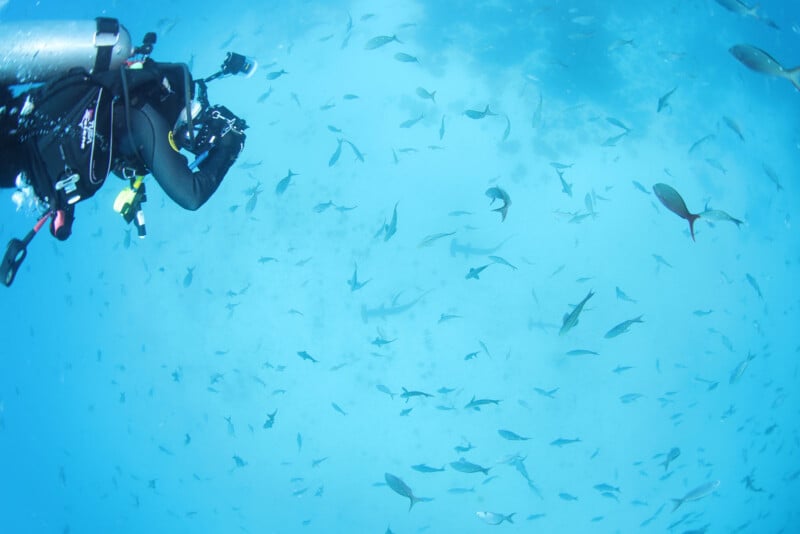
Miami-based photojournalist Alie Skowronski knew there was a news story in the Galápagos Islands. She dove in, literally, to produce a science story that she successfully pitched to The Associated Press about the impact of invasive species and climate change.
Skowronski took photos, shot video, and wrote the wire story. Her skill trifecta — photography, videography, and writing — illustrates the expanding role of news photographers.
More photographers are writing news content and shooting video, and more reporters are taking pictures and video.
“The tools of the trade have expanded for journalism, storytelling, and photography,” says Terry Eiler, who recently turned 80 and has been teaching photojournalism since the 1970s.
“The iPhone has become the default audio, video, and still-photo tool of run-and-gun narrative capture. Laptops, iPads, mirrorless cameras, and portable audio-video tools continue to be the professional equipment for quality reportage and storytelling. Traditional journalists should understand audio, visual image-making, and editing. Reporters’ notebooks and writing instruments are no longer the only tools in journalists’ pockets.”
Eiler co-founded the School of Visual Communication at Ohio University in 1986; he is now a professor emeritus.

Skowronski graduated from Ohio University in December of 2020, winning the prestigious William Randolph Hearst college photojournalism national championship awarded in 2021. Her college training included still photography, audio, and video.
“If I didn’t have any video training, I would have felt very unprepared,” says Skowronski.
All her media employers have required basic knowledge of shooting and producing video. She joined The Miami Herald as a photojournalist in April of 2022.
The Associated Press published Skowronski’s climate story from the Galápagos Islands on July 29. The AP’s global Week in Pictures for July 26 to August 1 included an underwater Galápagos Islands photo by Skowronski.
In July, The New York Times published a lengthy article on Loren Long’s best-selling illustrated book “The Yellow Bus.” It featured photos and video by Cincinnati-based freelance photographer Madeleine Hordinski.
“Most photographers have to shoot video sometimes,” says Hordinski, adding that she also shot video last year for a Washington Post story about an open-air gun range north of Cincinnati.
Photojournalists caution that shooting both stills and video should not undermine quality. Some images are more effective as still photos, they say. They also point out that journalists’ skill sets have broadened as news outlets downsized.
Managing news media has changed as photographers’ roles expanded. Visual journalists are more involved in brainstorming, planning, and presentation of stories.
Independent nonprofit newsroom ProPublica exemplifies this trend, hiring veteran photographer Boyzell Hosey in 2022 as senior editor for visual storytelling.
Hosey recalls a long-gone era, early in his career, when some photographers didn’t write captions for their pictures because that detail was handled by writers. For photographers to have “a seat at the table” of newsroom management, they must have skills beyond point-and-click photography, he says.
The Gannett-owned Columbus Dispatch has asked photojournalist Barbara J. Perenic to expand her role by working more closely with editors and reporters to develop and present stories. Perenic self-describes on Linkedin as “Visual Storyteller and Idea Piñata.”
Her post about robotic lawnmowers, published by The Dispatch September 2, featured video.
Perenic’s husband, sportswriter David Jablonski, has been shooting video since 2007.
“That was when we first had the ability at the Springfield News-Sun to put our own videos on the website. Reporters were given small camcorders. I enjoyed it right away,” says Jablonski. “It gave me a reason to be on the sideline, rather than in the press box.”
Cox First Media — which owns newspapers in Springfield, Dayton, and nearby Butler County — values videos and photos from reporters, says Jablonski. He is now a beat reporter at the Cox-owned Dayton Daily News, covering the University of Dayton Flyers and more.
Jablonski got a high-end digital Canon camera in 2012. Who taught him how to take pictures?
“I learned the basics from my wife,” he recalls, “but mostly I learned through trial and error.”
His crash course included photographing nearly 70 Cincinnati Reds games in 2013 in various lighting conditions.
“That caught me up fast,” says the writer/photographer/videographer pioneer.
About the author: Ken Klein lives in Silver Spring, Maryland; he is retired after a career in politics, lobbying, and media including The Associated Press and Gannett in Florida. Klein is an alumnus of Ohio University and a member of the Dean’s Advisory Council of the Scripps College of Communication. Professionally, he has worked for Fort Myers News-Press (Gannett), The Associated Press (Tallahassee), Senator Bob Graham, and the Outdoor Advertising Association of America (OAAA).
